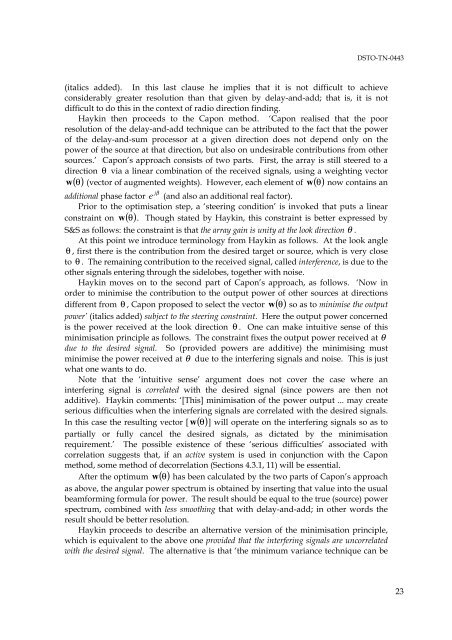Suitability of Correlation Arrays and Superresolution for Minehunting ...
Suitability of Correlation Arrays and Superresolution for Minehunting ...
Suitability of Correlation Arrays and Superresolution for Minehunting ...
Create successful ePaper yourself
Turn your PDF publications into a flip-book with our unique Google optimized e-Paper software.
DSTO-TN-0443<br />
(italics added). In this last clause he implies that it is not difficult to achieve<br />
considerably greater resolution than that given by delay-<strong>and</strong>-add; that is, it is not<br />
difficult to do this in the context <strong>of</strong> radio direction finding.<br />
Haykin then proceeds to the Capon method. ‘Capon realised that the poor<br />
resolution <strong>of</strong> the delay-<strong>and</strong>-add technique can be attributed to the fact that the power<br />
<strong>of</strong> the delay-<strong>and</strong>-sum processor at a given direction does not depend only on the<br />
power <strong>of</strong> the source at that direction, but also on undesirable contributions from other<br />
sources.’ Capon’s approach consists <strong>of</strong> two parts. First, the array is still steered to a<br />
direction θ via a linear combination <strong>of</strong> the received signals, using a weighting vector<br />
θ<br />
w θ now contains an<br />
w () (vector <strong>of</strong> augmented weights). However, each element <strong>of</strong> ()<br />
jβ<br />
additional phase factor e (<strong>and</strong> also an additional real factor).<br />
Prior to the optimisation step, a ‘steering condition’ is invoked that puts a linear<br />
constraint on w () θ . Though stated by Haykin, this constraint is better expressed by<br />
S&S as follows: the constraint is that the array gain is unity at the look direction θ .<br />
At this point we introduce terminology from Haykin as follows. At the look angle<br />
θ , first there is the contribution from the desired target or source, which is very close<br />
to θ . The remaining contribution to the received signal, called interference, is due to the<br />
other signals entering through the sidelobes, together with noise.<br />
Haykin moves on to the second part <strong>of</strong> Capon’s approach, as follows. ‘Now in<br />
order to minimise the contribution to the output power <strong>of</strong> other sources at directions<br />
different from θ , Capon proposed to select the vector w () θ so as to minimise the output<br />
power’ (italics added) subject to the steering constraint. Here the output power concerned<br />
is the power received at the look direction θ . One can make intuitive sense <strong>of</strong> this<br />
minimisation principle as follows. The constraint fixes the output power received at θ<br />
due to the desired signal. So (provided powers are additive) the minimising must<br />
minimise the power received at θ due to the interfering signals <strong>and</strong> noise. This is just<br />
what one wants to do.<br />
Note that the ‘intuitive sense’ argument does not cover the case where an<br />
interfering signal is correlated with the desired signal (since powers are then not<br />
additive). Haykin comments: ‘[This] minimisation <strong>of</strong> the power output ... may create<br />
serious difficulties when the interfering signals are correlated with the desired signals.<br />
In this case the resulting vector [ w () θ ] will operate on the interfering signals so as to<br />
partially or fully cancel the desired signals, as dictated by the minimisation<br />
requirement.’ The possible existence <strong>of</strong> these ‘serious difficulties’ associated with<br />
correlation suggests that, if an active system is used in conjunction with the Capon<br />
method, some method <strong>of</strong> decorrelation (Sections 4.3.1, 11) will be essential.<br />
After the optimum w () θ has been calculated by the two parts <strong>of</strong> Capon’s approach<br />
as above, the angular power spectrum is obtained by inserting that value into the usual<br />
beam<strong>for</strong>ming <strong>for</strong>mula <strong>for</strong> power. The result should be equal to the true (source) power<br />
spectrum, combined with less smoothing that with delay-<strong>and</strong>-add; in other words the<br />
result should be better resolution.<br />
Haykin proceeds to describe an alternative version <strong>of</strong> the minimisation principle,<br />
which is equivalent to the above one provided that the interfering signals are uncorrelated<br />
with the desired signal. The alternative is that ‘the minimum variance technique can be<br />
23

















